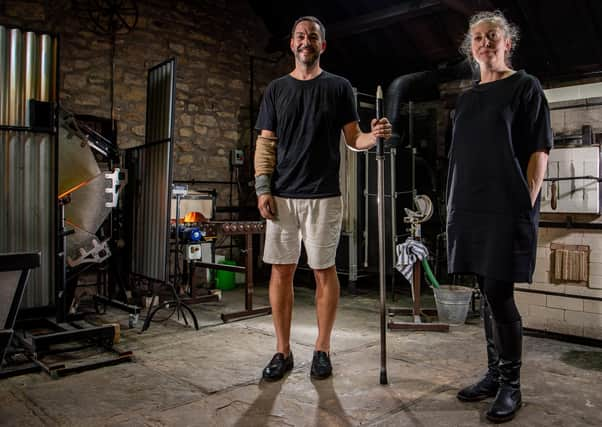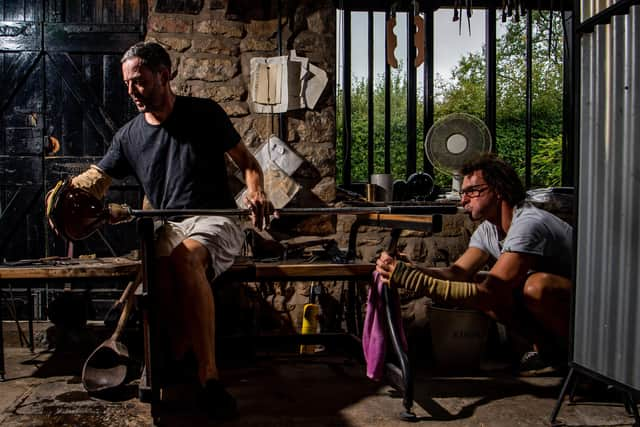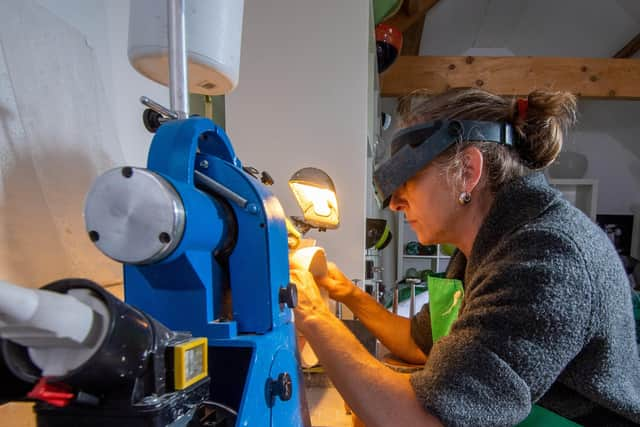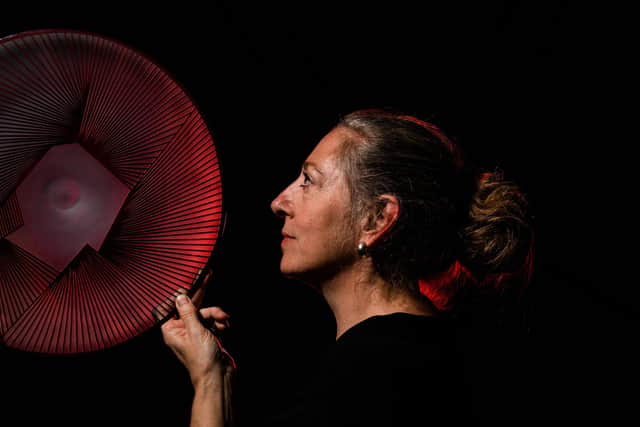Global impact of couple’s 25 years of glassmaking in the North York Moors


When Kate Jones and Stephen Gillies settled in the North York Moors village of Rosedale Abbey to establish their contemporary glassmaking business, Kate admits that they “shot for the moon”.
It’s testament to the couple’s focus and unrelenting passion for their craft that Gillies Jones, the business they founded, celebrates its 25th anniversary this year and their work now features in acclaimed collections around the world, including at the V&A Museum in London.
Advertisement
Hide AdAdvertisement
Hide AdAfter meeting at Stourbridge School of Art, Kate and Stephen toured the globe on a self-imposed apprenticeship, honing their skills alongside some of the world’s finest glass-makers.


Kate, who originates from West London, recalls: “We didn’t have any doubts about coming to Rosedale because we had a clear idea of what we wanted to do. After graduating, we went travelling, learning and working on an old-fashioned apprenticeship. Stephen wrote to people whose work he liked and said ‘give us a job’. He was like a man possessed and still is; he would rather blow glass than do anything else in this world. It’s who he is. He always wants to learn.”
Kate and Stephen’s apprenticeship took them to Denmark, the United States and Switzerland, where they spent time learning from acclaimed artists Philip Baldwin and Monica Guggisberg. Baldwin and Guggisberg studied at the Orrefors Glass School in Sweden and worked as assistants to master glassblower Wilke Adolfsson.
Years later, when Wilke invited Stephen to Sweden to work with him, they realised that they make glass in a very similar way because of the skills that Philip Baldwin had passed on from one to the other.
Advertisement
Hide AdAdvertisement
Hide AdKeen to continue this tradition of knowledge sharing, Kate and Stephen have provided work placements to up-and-coming glassmakers from around the world at their workshop in Rosedale.


According to Kate, the time spent abroad played an integral role in shaping the trademark style that typifies the work of Gillies Jones today. She likens the different methods of glassmaking to the languages of the countries from which they originate, explaining: “Like the Italian language, the Venetian style of glassmaking is flamboyant; you pull and push the glass around. The Scandinavian way is smooth and gentle, like the language.
“We have settled on the Scandinavian style; it’s a gentle way of moving the glass and making simple shapes; pure colours and forms. There is nowhere to hide with this style. It’s either right or it’s not. You can’t change it, so you have to have a good blank canvas.”
At college, Kate studied fine art and she credits Stephen with ‘converting’ her to glass, adding: “I’d spent four years learning how to paint so it was a long process trying to translate that sense of spontaneity onto glass. I hope that the pieces I work on look like that – that they have the immediacy of a painting.”
Advertisement
Hide AdAdvertisement
Hide AdToday, they each have distinct roles in the production of their designs. Stephen blows all of the glass by hand, adding layers of colour and ‘making things as well as he can possibly make them’, according to Kate.


He is assisted in the workshop by his brother, Dave, who joined Gillies Jones seven years ago, and they work alongside the searing heat of the furnace from 7.30 in the morning until mid-afternoon most days.
Kate designs each piece and adds texture to the surface of the glass using a combination of sandblasting, wheel engraving and other techniques, before it is cleaned and polished.
She describes this as ‘mark making’, but jokingly adds: “Stephen does the hot sweaty bit and I do the dusty bit. Our skill sets are very different.” Kate’s training as a painter taught her to look at the world around her and this is evident in the work of Gillies Jones, although she believes their designs have gradually become more specific to Rosedale as the years have passed.
Advertisement
Hide AdAdvertisement
Hide Ad“The more time you spend here, the more you see,” she explains. “My little bit of wilderness is the wild flowers that get a toehold on the roadside verges here in the National Park, which are now wildlife corridors. There are huge debates raging about the use of this landscape. The landscape is manufactured and processed, and the farmers work hard to keep it that way. It’s agricultural – grazing and hay making – in the dale and managed for grouse shooting on the moors above.”


She finds the history behind it all fascinating. “There are marks left by heavy industry because in the late 1800s the best quality magnetic iron stone was found here and the population of the village grew from around 250 people to 3,000 overnight. Stone from Rosedale Priory and other structures were taken to construct the mine.”
The knowledge they gathered on their extended apprenticeship convinced Stephen and Kate that they could establish their business pretty much anywhere, but family connections brought them to Rosedale. Stephen’s late father was born in nearby Helmsley, and his ancestors came from across the North York Moors. Although Stephen was raised in West Yorkshire, his father bought a house in Rosedale when he retired.
By settling in the village, Kate and Stephen were resurrecting a glass-making tradition dating back to the 1500s, when what Kate describes as a ‘band of renegade French glass blowers’ lived and worked in the area. In Elizabethan times, fine blown glass was highly prized, and its production was strictly controlled by the Crown, resulting in glass being made and sold illicitly.
Advertisement
Hide AdAdvertisement
Hide Ad“They were Huguenots and their names appear in the church register at Lastingham but disappear by the early 1600s,” explains Kate. “They are thought to have been evicted as the furnace they used was left intact.
“The Crown gave control of glassmaking to Sir Jerome Bowes and anyone without a license was shut down. Glassmaking was considered magical and most came from Venice in those days, but they smuggled the odd maker out of there, although they were often topped off!”
The Elizabethan furnace used by Rosedale’s illicit glassmakers was unearthed in the 1960s and now forms part of the collection at Ryedale Folk Museum in nearby Hutton-le-Hole.


Although the furnace that Stephen uses today is undoubtedly more hi-tech, the methods he uses remain largely unchanged from the 17th century.
Advertisement
Hide AdAdvertisement
Hide Ad“There were forest furnaces all over the country and they would have been small-scale operations, like this,” says Kate. “The Industrial Revolution meant that everything was upscaled to huge centres, so that things could be made cheaper and faster. It has gone full circle and we’ve now moved back to small-scale studios, like ours.”
Rosedale proved to be the ideal place for Stephen and Kate to raise their own family, daughter Ava, 21, and son, Finn, 16. “I can’t imagine living anywhere else, it’s a vibrant community and I think that now more of us have realised that we can work from home there will be more people coming to live and work in villages like Rosedale. Technology means that there are no barriers to rural life.”
Kate hopes to develop her work further and enjoy more time being creative, walking and looking at the world around her. “It’s a way of life, and it’s craft in its purest sense. It’s something you want to do every day and it’s not about upscaling. It gives you a quality of life.”
An exhibition of the work of Gillies Jones at The Inspired by… gallery, which is based at the Moors National Park Centre at Danby, to mark Kate and Stephen’s 25th anniversary of working together in Rosedale Abbey. Entitled A Portrait of Place, it runs until Nov 9. November. For more information, visit www.northyorkmoors.org.uk.
Advertisement
Hide AdAdvertisement
Hide AdSupport The Yorkshire Post and become a subscriber today. Your subscription will help us to continue to bring quality news to the people of Yorkshire. In return, you’ll see fewer ads on site, get free access to our app and receive exclusive members-only offers. Click here to subscribe.
Comment Guidelines
National World encourages reader discussion on our stories. User feedback, insights and back-and-forth exchanges add a rich layer of context to reporting. Please review our Community Guidelines before commenting.